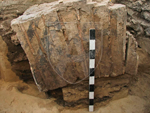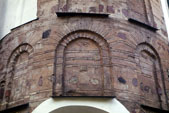Masons at Work
Oleg Ioannissian and Gleb Ivakin
St Petersburg State Hermitage Museum and the Institute of Archaeology, Kiev

Oleg Ioannissian and Gleb Ivakin
St Petersburg State Hermitage Museum and the Institute of Archaeology, Kiev
Construction Materials and Building Constructions in the Architecture of Medieval Rus, from the 10th to the Beginning of the 12th Centuries
Prior to the adoption of Christianity as the official religion (988) in Rus, stone construction was not used there, and wood was used as the primary building material. The first stone buildings of Rus were the Tithe Church and, adjacent to it, the ensemble of palace buildings in Kiev. Here for the first time lime mortar with the addition of pounded burned clay and thin bricks (plinths) has been applied in the construction practice of Rus. Along with the plinths, stone (sandstone and quartzite) was used in the masonry. It followed the Byzantine technique «opus mixtum». Foundations were constructed of stone and brick, held together by mortar. They overlapped strips casted into ditches. Still it was believed that Tithe Church was was cross-domed building, but recent excavations of the monument (2005–2011) showed that it belonged to a type of domed basilica with transept. This has led to a review of the prevailing viewpoint on the origin of old Russian architecture. It was believed that the old Russian architecture lies in Costantinople's construction tradition, but now the important role played the Balkan (Bulgarian) tradition of construction and architecture in conjunciton with the Byzantine traditions becomes understandable in formation of Russian architectural traditions . Focus on Constantinople and the use of cross-domed building type becomes notable only in the mid-11th century (Sofia Cathedrals in Kiev, Novgorod and Polotsk and other Kievan buildings of the middle and the second part of 11th century). Rus formed its own architectural type, created on the basis of the Byzantine tradition later at the end of the 11th and into the first third of the 12th century. Throughout this period (from the late 10th untill the first third of the 12th century), the main and almost sole construction centre of Rus was Kiev where masons used «opus mixtum» masonry with a concealed course. However, already since the beginning of 12th century separate building centres had arisen in Chernigov and Novgorod. Novgorod at first fully followed Kievan architectural traditions, but the proportion of stone in the construction of walls here are significantly higher than that of brick. In Chernigov there were changes in architectural style and technique of masonry. Masonry with concealed course changed to the masonry with the equivalent layers, and in architectural forms there is an evident impact of romanesque architecture.


